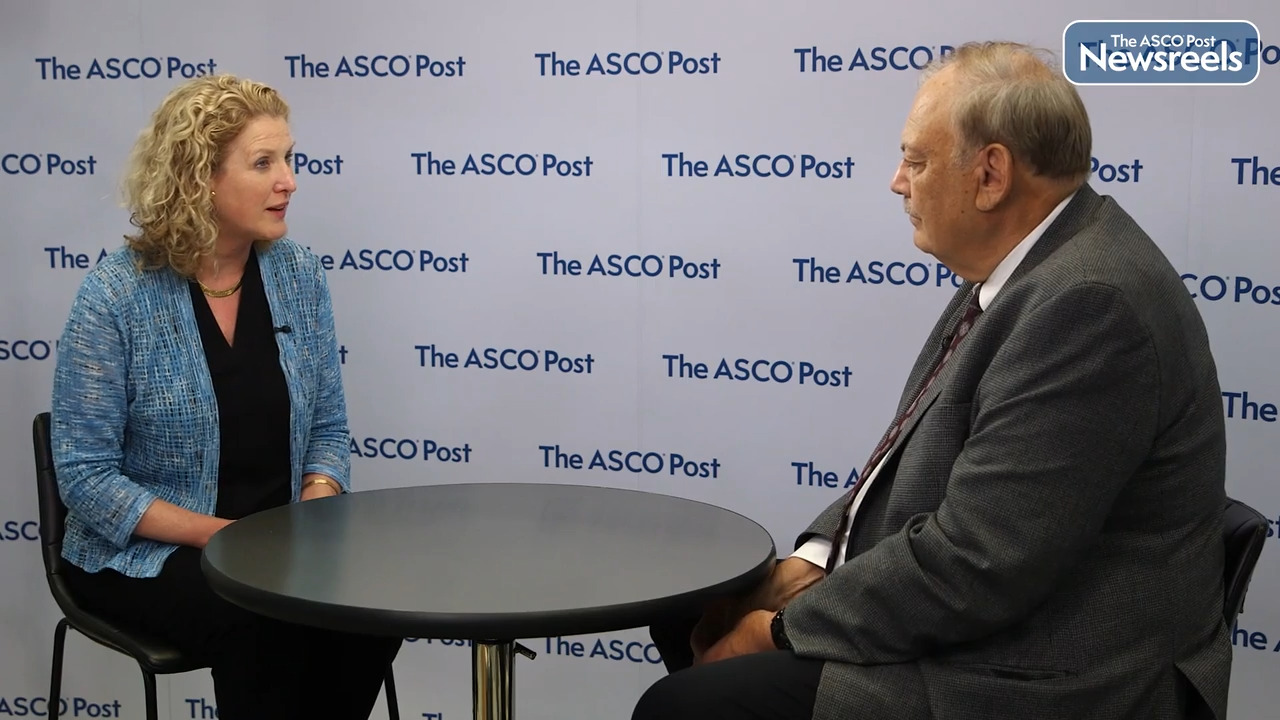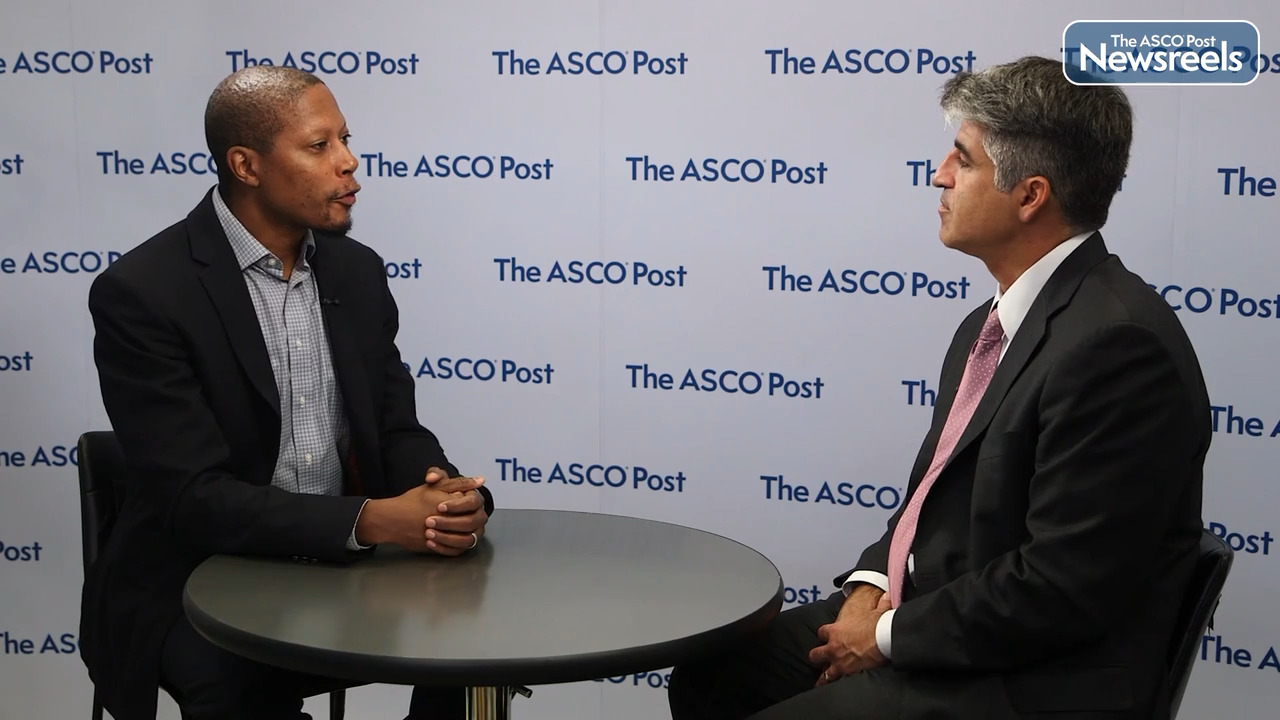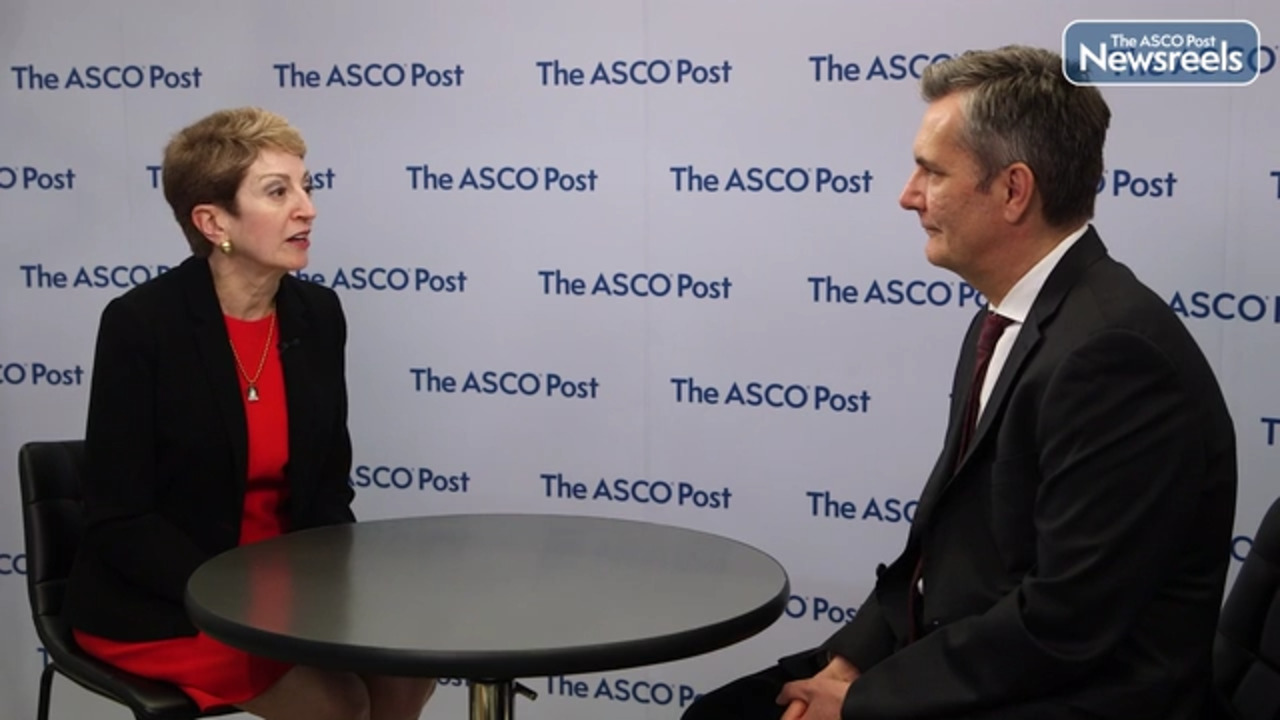Transcript
Disclaimer: This video transcript has not been proofread or edited and may contain errors.
Rana R. McKay:
We're so excited to hear updated long term follow-up from KEYNOTE-426. Tell us a little bit about the study design.
Brian I. Rini:
Yeah, so this was a typical IO doublet study design, frontline clear cell kidney cancer patients randomized equally to Sunitinib, the old TKI monotherapy standard of control, or Pembro-Axi, Pembro given I guess every three weeks at that point, and Axi, five BID. Very typical of one of these advanced kidney cancer studies.
Rana R. McKay:
We've been following this study for a long time and we're excited to hear the long-term follow-up data. Can you share some of the insights from now 67 months follow up?
Brian I. Rini:
Yeah, the median was 67 months and a minimum five years, so that's kind of a threshold and it's the TKI-IO combo with the longest follow up, so, I think it's really important. As you know we have IPI/NIVO data, which is about two years ahead and noted with durability, right? And the IO-TKIs have sort of lagged behind in terms of the data just because of the way the trials accrued. So, what you see, not surprisingly, is maintenance of response rate advantage in PFS's numbers haven't changed much, right? Because all those events largely have happened. And then you see an updated overall survival, a hazard ratio, 0.84. So, that has drifted up over the analysis. Remember it was 0.53 at the very first analysis, so I think what we're learning about IO-TKI is they have this dramatic effect up front, right? Tumor shrinkage and other effects up front, and then we're seeing the curves come together a little bit over time. So, I think it'll generate some interesting discussion.
Rana R. McKay:
Yeah. Tell me a little bit about that. I think one of the biggest pluses about the NIVO/IPI is that it's associated with long-term durability. We're seeing this plateauing of the PFS curve over time, and who's to know if that's due to censoring and various other iterations of the trial. But how do you see the durability with regards to 426?
Brian I. Rini:
So, there were 18% of patients progression free at five years, right? It was 30% with IPI/NIVO, 18 of course comparing across trials and all the caveats. So, I think there is a tail of the curve. I think at five years out we can now say that there are patients who get IO-TKI that are going to have durable disease control. Remission, whatever term we want to use. Whether it's higher with a CTLA-4 containing regimen. I'm sure the field's going to debate and discuss over the next months and years. And I think it's just something we haven't sorted out in kidney cancer. As I said, early tumor shrinkage advantages to these regimens versus potential later advantages still in a subset of patients for an all immune approach.
Rana R. McKay:
Yeah, I thought what was really striking to see was the duration of response data and in those patients who are actually able to achieve a response, that the tail may even be a little bit more pronounced potentially. But maybe that's looking into the data too much.
Brian I. Rini:
Yeah, I don't know, I mean the median's about two years for all the IO-TKI combos. That tail is at about 30% I think. So again, patients who respond well to immune therapy tend to be durable, right?
Rana R. McKay:
Yeah.
Brian I. Rini:
That's true for every immune therapy, and it's probably more true for a dual immune therapy, I think.
So, still a lot to learn clear's presenting a four-year follow-up data with a pretty similar story. CABO-NIVO, I'm sure will update and have a very similar story. So, in that way the data's very consistent, and I think like everything, we're just getting smarter over time.
Rana R. McKay:
Yeah. Tell me a little bit about the subsequent line therapies because it's really intriguing to see that actually a lot of patients ended up receiving a second line treatment, which may not necessarily be what we see in just real world data series.
Brian I. Rini:
Yeah, so there was no crossover on trial, but if you look, the vast majority of patients have discontinued by now. Of course, if you look at the Sunitinib arm, I think it was 80 some percent of patients got subsequent therapy. 80% of those patients got PD-1 therapy, 75% also got a VEGF therapy, and I think even 25% got four total lines of therapy. So there is, as you well know, there is a subset of patients who will get sequential therapy and do well, right? The median survival and the PEM-AXI arm was four years with the PFS of 16 months. So, most of that time is spent post progression.
And as you know, we have a number of active drugs, and I think that in part explains a bit of those survival curves.
Rana R. McKay:
Yeah.
Brian I. Rini:
Why I would argue against TKI monotherapy is you don't know who those patients are on day one, right? We can talk about biomarkers and predictors, we don't have anything very good. So, you don't know, oh, this is a indolent patient and I have the luxury of time for two, three, four treatments. So, I'm a big proponent of IO therapy upfront.
Rana R. McKay:
Yeah. No, that's very exciting. It's very encouraging actually, to see that in the context of the clinical trials that were done, that the majority of patients are going on to receive second line therapy and the real world dataset, we see huge drop off. At each iteration, 50% of people drop off, they don't see second line. Then another 50% drop off, they don't see third line. So, I do think that that's probably coloring the OS signal, as people are going on to receive subsequent lines of therapy.
Brian I. Rini:
I think so. I mean, we want patients to receive subsequent therapy. Even if there's no crossover on a trial, which is very difficult to do. I think it is reassuring that this was kind of real world, right? As real world as a trial can be I guess, yeah.
Rana R. McKay:
Yeah. So come Monday morning, how do you think this is going to impact our practice? Do you think it's going to make big sways one way or another? Is it going to-
Brian I. Rini:
I don't think so. I mean, if you're an IO-TKI person, you're probably still an IO-TKI person. I don't think it sways you into an all immune camp. There are people out there who will disagree with me, we probably know who they are. If you're using PEM-AXI or LEN-PEM or CABO-NIVO, I don't think it's going to switch you into another one. So, it's important data and the clear data, I think compliments it. But I'm not sure at a clinical level that it's going to make massive shifts.
Rana R. McKay:
Yeah.
Brian I. Rini:
Yeah.
Rana R. McKay:
Well, thank you so much for your work and energy on KEYNOTE-426. It's really a landmark study that has changed the way we practice.
Brian I. Rini:
Thank you.
Rana R. McKay:
Appreciate it.
Brian I. Rini:
Appreciate it.




